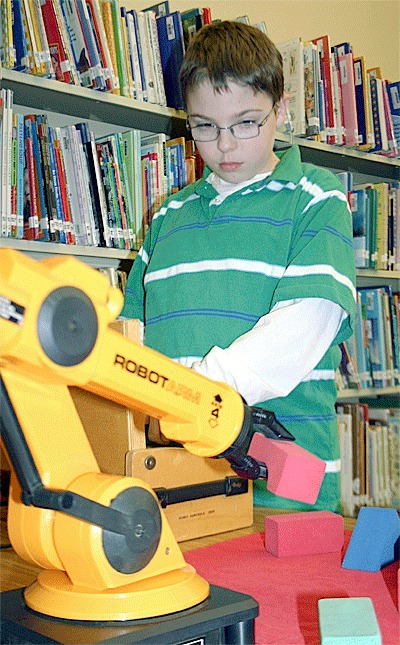Elementary school students jetted into the outer realms of education when the Pacific Science Center outreach visited Olympic View Elementary School Jan. 30.
“Space Odyssey” was the theme and educators brought a variety of props to the delight of starry-eyed kids. Children enjoyed free play in the library with a robotic arm that picked up blocks while others lined up to hop on a spinning disc that taught about forces.
Scales showed kids’ weights on different planets and a piece of meteorite was available to touch. Puzzles and information stations completed a hands-on astronomy education.
Navy volunteers from VQ-1 helped the children with each station.
In the classrooms, Pacific Science Center outreach educators awed children with lessons about light in space, planning a trip to Mars and more. Students donned colorful glasses to view lit tubes containing various gases, simulating light that comes from stars. Scientists use spectroscopy work like this to study relationships between matter and energy.
“Not all kids in Washington have the opportunity to come to the Science Center and engage in interactive activities so we bring it to them,” said Rose Chartier, outreach education teacher for the Outreach Education Department of the Pacific Science Center.
“We’re teaching kids that science is a fun thing to do,” she added.
And it seemed like the kids were enjoying their day as they learned about the landing on Mars and planned where they would land a shuttle or rover. Other hands-on activities not only got children excited about astronomy but about learning in general.
“You can fit 50 moons into the earth,” said Braxton Vawter, a third-grader. He was most excited about the robotic arm set up in the library.
“You can control it. It’s kind of like driving like what they use on another planet,” Vawter said.
After a day of busily absorbing new information, many of the elementary schoolers were bubbling with freshly learned facts.
“There’s no air in space,” said Siobhan Smith. Her favorite hands-on activity was creating constellations.
“I made my own constellation out of elastics,” Smith said. It looked remarkably like a peace sign.
Rolland Weatherlow enjoyed the simulation of driving a rover on Mars and learning about the Mars landing. He even picked the correct spot to land a shuttle. After touching the meteorite and playing with the robotic arm, Weatherlow said he is ready to launch into space and search for rocks and minerals on other planets.
“You should go to the moon. You might find stuff,” he said.
“It’s a big hit with the kids. They like coming down here,” said Lisa Latta, a volunteer with the Parent-Teacher Organization, which funded the event with help from the ASB.
There’s something for all the kids, said PTO volunteer Angela Ward. Special education students usually don’t get to participate in events like this but there was something for everyone that day, Ward said.



